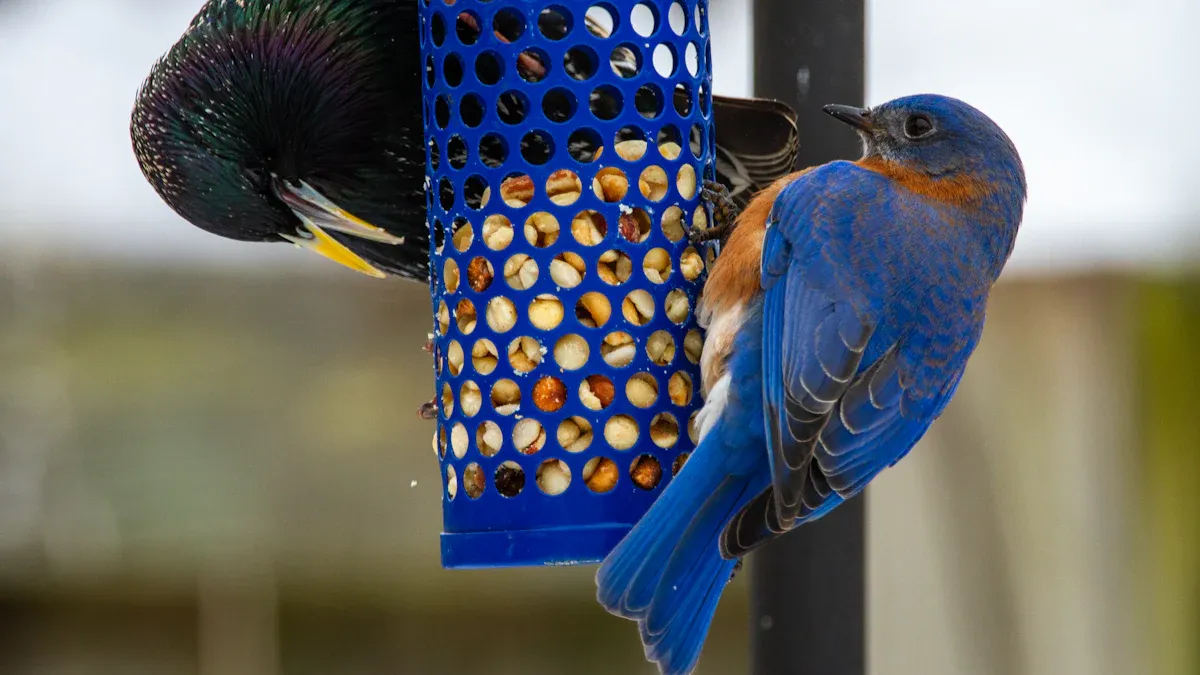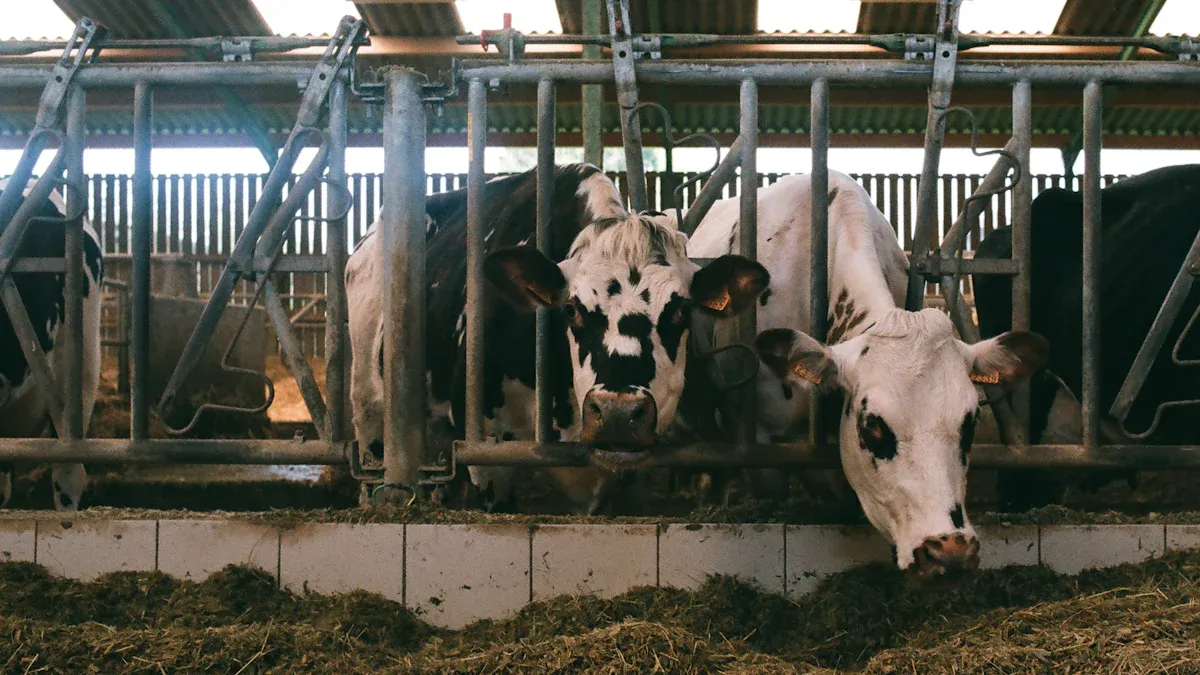
You’ve probably heard about the environmental toll of livestock farming. Did you know about a third of global cereal production feeds animals instead of people? That’s where mealworms come in. These tiny insects pack 51.93 g of protein per 100 g and offer a sustainable option for feeding livestock and even wild birds dried mealworms. Additionally, when considering the best sources for these nutritious insects, it’s important to look into the top mealworm manufacturers to ensure quality and sustainability.
Key Takeaways
- Mealworms are a green feed choice. They need less land and water than regular livestock, so they help the planet.
- They are rich in protein, better than soy or fishmeal. This makes them great for feeding animals and birds.
- Using mealworms helps cut greenhouse gases and supports smart farming.
Why Mealworms Are a Sustainable Feed Option
Life Cycle and Farming of Mealworms
Mealworms might be small, but their life cycle is fascinating. They start as eggs laid by adult beetles, and each female can lay up to 500 eggs. These eggs hatch into larvae, which grow for about 3–4 months before turning into pupae. After 10–30 days, the pupae transform into adult beetles, and the cycle begins again. This efficient life cycle makes mealworms an excellent option for farming.
You’ll be amazed at how resource-efficient mealworms are. They convert feed into protein as effectively as chickens and even outperform cattle in nitrogen utilization. With a feed conversion ratio (FCR) as low as 2.2, mealworms require far fewer resources than traditional livestock. This means you can produce more protein with less feed, water, and land.
Nutritional Value and Protein Content
Mealworms are nutritional powerhouses. They contain 47–60% protein and 31–43% lipids, making them a rich source of energy. Plus, they’re packed with essential amino acids, omega-3 and omega-6 fatty acids, and oleic acid. Compared to conventional meat, mealworms provide more calories and protein per 100 grams.
If you’re feeding animals like poultry or even wild birds dried mealworms, you’re giving them a highly nutritious meal. While mealworms are slightly less digestible than vertebrate protein, their overall nutritional profile makes them a fantastic alternative to traditional feed sources like soybeans.
Environmental Benefits of Mealworm Farming
Mealworm farming is a game-changer for the environment. Producing 1 kg of edible mealworm protein uses only 22.38 m² of land, which is just 10% of what’s needed for beef production. Their water footprint is also impressively low—3.5 times less than beef.
Mealworms emit fewer greenhouse gases like CO2, N2O, and CH4 compared to cattle, helping reduce global warming potential. They also produce less ammonia, which improves air quality and reduces eutrophication. By choosing mealworms, you’re supporting a sustainable and eco-friendly solution for animal feed.
Applications of Mealworms in Animal Feed

Wild Birds Dried Mealworms and Their Uses
If you’ve ever fed wild birds, you know how important it is to provide them with a nutritious diet. Wild birds dried mealworms are a fantastic option. They’re packed with protein, essential amino acids, and beneficial fatty acids that keep birds healthy and energetic. Whether you’re feeding backyard songbirds or exotic species, mealworms offer a nutrient-dense snack that supports their overall well-being.
Mealworms are also incredibly versatile. You can serve them whole, mix them into birdseed, or even grind them into powder for custom blends. Their mild, nutty flavor makes them appealing to a wide range of bird species. Plus, they’re easy to store and handle, making them a convenient choice for bird enthusiasts.
Research shows that mealworms can replace traditional feed sources like fishmeal or soymeal without compromising nutritional value. Birds thrive on mealworms, and their health benefits make them a superior alternative to conventional options.
Mealworms in Livestock Feed (Poultry, Fish, Pigs)
Mealworms aren’t just for birds—they’re a game-changer for livestock too. Studies reveal that replacing soybean meal with dried mealworms in poultry diets improves growth performance and feed efficiency. Broiler chickens fed mealworm-based diets gain weight faster and convert feed into energy more effectively.
Fish and pigs also benefit from mealworm-based feed. For fish, mealworms enhance growth and improve meat quality by boosting their fatty acid profiles. Pigs experience better digestibility and overall health when mealworms are included in their diets. With their high protein content and essential nutrients, mealworms are a practical and sustainable choice for livestock feed.
Comparison with Traditional Feed Sources (Soy, Fishmeal)
How do mealworms stack up against traditional feed sources like soy and fishmeal? The results are impressive. Mealworms contain up to 60% protein, surpassing soybeans, which average around 44%. They also have a similar amino acid profile to fishmeal, making them an excellent substitute.
A study by Toviho & Bársony (2022) found that mealworms deliver equivalent or even improved growth performance compared to fishmeal or soybean meal. Another study highlighted that egg production increased by 2.4% when mealworms were included in poultry diets. These findings prove that mealworms aren’t just a sustainable option—they’re a highly effective one too.
| Study Reference | Findings | Nutritional Comparison | Performance Metrics |
|---|---|---|---|
| Toviho & Bársony, 2022 | Mealworms can replace fish or soybean meal | Identical essential amino acids | Improved growth performance and digestibility |
| Makkar et al., 2014 | Egg production increased with mealworms | Higher egg ratio (2.4%) | No negative effects on feed efficiency |
| Gasco et al., 2019 | Enhanced growth and meat quality | Improved fatty acid profile | Better digestibility |
Mealworms outperform traditional feeds in sustainability and nutrition, making them a smart choice for the future of animal feed.
Challenges and Opportunities in Mealworm-Based Feed
Regulatory and Industry Standards
Navigating regulations can feel like a maze when it comes to mealworm-based feed. Different regions have varying rules, which can slow down market growth. For example, the European Regulation (EU) 2015/2283 classifies insects as a “Novel Food” category. This ensures safety but also requires strict compliance for commercialization.
Another challenge is ensuring ethical farming practices. Research highlights concerns about mealworm welfare, like their treatment and living conditions. Setting clear welfare standards can help address these issues while building trust in the industry.
Despite these hurdles, regulations also create opportunities. They provide a framework for safe production, which can boost consumer confidence. As more countries adopt similar standards, the global market for mealworm-based feed could expand significantly.
Consumer Perception and Market Acceptance
Let’s face it—eating insects isn’t everyone’s cup of tea. Western consumers often hesitate due to cultural and psychological barriers. However, they’re more open to using insects as animal feed. Younger generations, influenced by sustainability trends, are showing greater acceptance.
Neophobia, or the fear of trying unfamiliar foods, plays a big role here. But as awareness grows, so does acceptance. Pet food markets, for instance, are already embracing mealworms due to their high protein content and natural appeal. This shift in perception could pave the way for broader adoption in livestock feed.
Scaling Production and Research Opportunities
Scaling up mealworm farming isn’t without its challenges. High initial costs and the need for advanced technology can make it tough. Efficient supply chains are also crucial for large-scale production.
On the bright side, research and development are driving innovation. Studies show that mealworms use 43% less land than milk production and emit far fewer greenhouse gases than beef or pork. These advantages make them a promising alternative. Pilot projects and stakeholder collaborations can further unlock their potential, making mealworm-based feed a scalable and sustainable solution.
| Animal Protein Source | Land Use (kg per kg of protein) | GHG Emissions |
|---|---|---|
| Mealworms | 43% of milk | Much less than chicken or beef |
| Chicken | 100% | Higher than mealworms |
| Beef | 10 times more than mealworms | Highest GHG emissions |
By addressing these challenges and seizing opportunities, you can help shape a future where mealworms play a key role in sustainable animal feed practices.
Mealworms are a game-changer for sustainable animal feed. They’re packed with protein, eco-friendly, and versatile. By choosing mealworm-based feed, you’re supporting a greener future.
Let’s embrace this innovative solution! Encourage more research, spread awareness, and support mealworm farming. Together, we can make animal feed practices more sustainable. 🌱
FAQ
What makes mealworms better than traditional feed sources like soy or fishmeal?
Mealworms offer higher protein content, require less land and water, and emit fewer greenhouse gases. They’re a sustainable and eco-friendly alternative. 🌱
Can mealworms replace all types of animal feed?
Not entirely. Mealworms work best as a supplement or partial replacement in diets for poultry, fish, and pigs. They enhance nutrition and sustainability.
Are mealworms safe for animals to eat?
Yes! Mealworms are safe and nutritious. They’re rich in protein, essential amino acids, and healthy fats, making them ideal for animal feed.
Tip: Always source mealworms from reputable suppliers to ensure quality and safety.


